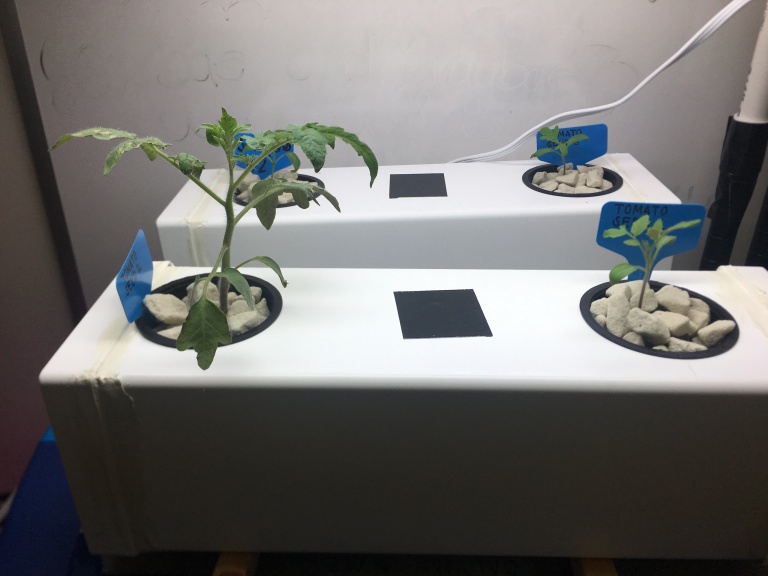I have talked about my STEM quarter one project in a previous blog regarding a lot of the building of our aeroponic system, and how one of our plants began growing much sooner than all the other. A lot has happened since that last blog, which was about two weeks ago, and I am very anxious to share all the great improvements we have been witnessing. Calvin and I are extremely pleased with the results we are getting and how well and sustainable our system is. There have not been any technical problems, which has made our growing process extremely fun and rewarding.
Our three tomato plants and one jalapeno plant have been in the system for two weeks as of today (Friday, October 28th). After one of out tomato plants was being ‘babysat’ in one of the neighboring system, we were extremely worried because it did not look so healthy the day we transferred it to our system. Although, we saw such a huge improvement in it’s health after just one hour in a fully functioning system. The tomato plants prove to be very resilient to many types of condition. The day we transferred our biggest plant into our system, we also put the other three plants in. Today, they are looking much bigger than they did, and are seeing to grow very well. Last week on Friday (October 21st), we changed the water in the system, which was a huge long process that took just about the full two hours of class.

Plants right after they were removed from the temporary system

A couple of hours later (looking so much more healthy
The water changing process is extensive (for our project at least), and must be done completely correct or else something could go really wrong. For example, the pump could not be connected all the way, and the plants would not get water, or we could forget to plug something in. Additionally, we could have too many or too little nutrients which could be detrimental to the health of our plants. Lastly, the pH could be too acidic or basic, which would prohibit the plant from growing as well as it could in the ideal conditions. Taking all of these factors into consideration, it is essential that we are fully focused when changing the water and putting our system back together.
Additionally, Calvin and I have added a lot of sensors to measure different nutrients and factors of the water in our system. We first put the sensors in last week but they seemed a little problematic, since we did not have enough time to make sure they were all working correctly. After we tried fixing them, it just felt like no matter what they were not giving us the correct readings. Although, the pH was working and a few others like calcium and nitrates, other than that it was not giving us correct readings. We are hoping that in the weeks to come we can figure out what is wrong with the readings. We are testing for salinity, pH, temperature, nitrates, ammonium, chloride, and calcium. Once we get accurate data, it is going to be really interesting to see what happens to the levels of these parts in the water.
This week, we also begun looking at energy, and how energy plays an incredibly important role in the growing of our plants. We focused a lot on light, and just how much wattage it gives off. Additionally, we looked at the light spectrum, and analyzed what type of light is emitted by our lights and compared it to what the most favorable type of light is for our plant. One of the most interesting things that I saw was the fact that the wattage required by our lights, is significantly less than the wattage required by household items such as microwaves, hairdryers, etc.
I’m eager to get the sensors up and really working so that we can see what happens to different aspect of the water as we run it through out system. I am also very excited to keep learning about how energy is absorbed by our plants (which I am currently learning in biology).